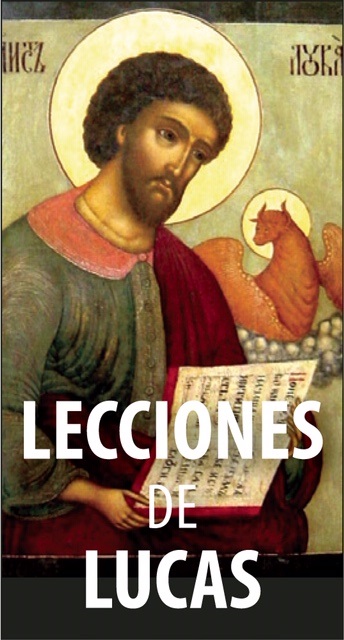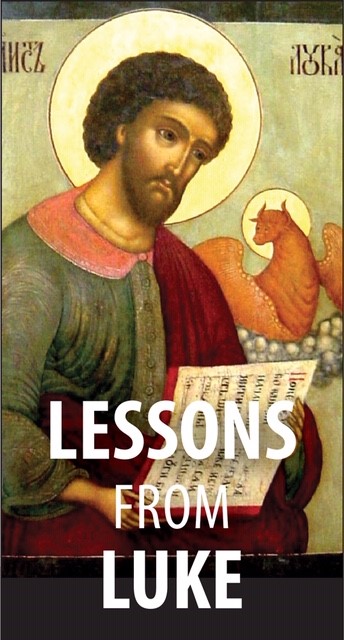Lecciones de Lucas—Artículo #5
Junio 2019
Jesús revela la generosidad de Dios
Cackie Upchurch de Estudio Bíblico de Little Rock

“¿Quién dicen ustedes que soy yo?” Esta pregunta está en el centro del Evangelio. Es la pregunta que Jesús nos hace a cada uno de nosotros, como se la hizo a sus primeros seguidores (Mateo 16,13-20; Marcos 8,27-30; Lucas 9,18-21).
Cada uno de los evangelistas trataron de alguna manera de responder a la pregunta sobre la identidad de Jesús personalmente, así como para la comunidad a la que se estaba dirigiendo originalmente. Todos ellos habían tenido la experiencia del mismo hombre, escuchado la misma enseñanza, lo habían acompañado en la misma serie de acontecimientos, y sin embargo cada evangelista ofreció algo ligeramente distinto. Es como cuando se desvela una escultura y cada espectador aprecia algún aspecto de la pieza de una manera especial. La escultura es la misma; el impacto es único.
Los lectores a menudo describen el Mateo de Jesús como el gran maestro y cumplimiento de las expectativas, el de Marcos como el Mesías sufriente, y el de Juan como el Hijo divino de Dios. Estos retratos puede que estén demasiado simplificados, y sin embargo reconocen las diferencias en énfasis. ¿Qué notamos sobre el retrato de Jesús que hace Lucas? ¿Quién dice Lucas que es Jesús? ¿Y cómo lo revela Lucas?
El leer el tercer Evangelio y escucharlo proclamado como lo estamos hacienda en este año litúrgico, Podemos apreciar la imagen de Jesús que emerge: Salvador del mundo y sanador compasivo. Estas descripciones tienen algo en común: la generosidad. La generosidad de Jesús, y su gentileza al extenderse hacia otros e incluso entregar su propia persona, brillan en el Evangelio de Lucas.
La oración o cántico de María cuando estaba embarazada de Jesús, el Magnificat (cap. 1), alaba el cuidado de Dios hacia quienes no tienen voz. El propio ministerio de Jesús como adulto se lanza con un lenguaje parecido en su proclamación de las palabras de Isaías en la sinagoga de su pueblo, Nazaret (cap. 4). Ahí él proclama que en él se ha cumplido el tiempo de traer la buena noticia a los pobres, libertad a los cautivos, vista a los ciegos y liberación a los oprimidos. Estas dos piezas marcan el tono de la misión de Jesús hacia aquellos que están en los márgenes de la sociedad.
Jesús abraza y sana a todo tipo de personas cuyas condiciones los calificaban de “impuros”, dejándolos fuera de las cálidas relaciones de la comunidad. Sana a leprosos y a paralíticos (5,12-14; 17,17-24), expulse a demonios de los atormentados por el mal (6,18; 9,37-43), perdona a una mujer cuya mala reputación es conocida de todos (7,36-50), cura a una mujer que ha tenido hemorragias por años y trae a la vida a una niña que se pensaba muerta (8,40-456), sana a un hombre enfermo de hidropesía (14,1-4), y devuelve la vista a los ciegos (18,35-43).
Cuando enseña, sus parábolas también enfatizan su generosidad. Sus historias revelan que su misión es para los marginados, los perdidos, o los que han sido ignorados. Vemos esto en el capítulo 15, con las parábolas de la oveja perdida, la moneda perdida, el hijo perdido. Tenemos un sentido de este amplio tipo de inclusión en la parábola del banquete al que se trajo a tullidos, ciegos y cojos (14,15-24). Jesús acerca a los niños y los usa para enseñar sobre la actitud que se pide a quienes están destinados al reino de Dios (18,15-17).
En el Evangelio de Lucas, escrito unos cuarenta años después de la resurrección, vemos un retrato de Jesús como el de quien llama a todos a la experiencia del reino de Dios. Él obra maravillas para quienes están fuera de la comunidad del judaísmo, o por los que no se tiene gran estima—curando al esclavo del centurión romano (7,1-10), y comiendo con recaudadores de impuestos como Zaqueo (19,1-10).
Si seguimos leyendo el Segundo volumen de Lucas, los Hechos de los Apóstoles, descubrimos que de hecho el Evangelio se proclama no sólo en la tierra de Israel, sino a “todos los confines de la tierra.” Los seguidores de Jesús se reparten por toda la región del Mar Mediterráneo, proclamando el amor generoso de Dios, estableciendo comunidades de creyentes y al fin dando la bienvenida a los gentiles (no judíos) en la comunidad de creyentes.
Para los de la comunidad de Lucas, los primeros oyentes de su Evangelio, Jesús se dispone a reunir a un pueblo y son los beneficiarios de su misericordia y sanación. Saben que su sacrificio en la vida y en la muerte abre las puertas a una fe que no está definida por la raza, la etnicidad o la cultura.
Preguntas para la discusión y reflexión:
-
¿Cuándo se ha ampliado o profundizado tu experiencia de Jesús al escuchar la experiencia de otra persona que podría ser distinta de la tuya?
-
Ojea el Evangelio de Lucas, volviendo las páginas y leyendo los titulillos de la narración. ¿Qué imagen empieza a emerger de esa sencilla práctica?
-
¿En qué situaciones te has dado cuenta de la generosidad de Dios—en tu propia vida y en las de otros?
-
Si tuvieras que contestar la pregunta de Jesús, “¿Quién dicen ustedes que soy yo?”, ¿qué dirías? ¿Cómo describirías tu experiencia de Jesús según ha cambiado a lo largo de tu vida?
Lecciones de Lucas - Artículo 4
Lessons from Luke—Article 5
June 2019
Jesus reveals God’s generosity
Cackie Upchurch of Little Rock Scripture Study
 “Who do you say that I am?” This question is the heart of the Gospel. It is the question Jesus asks each of us, just as he asked his first followers (Matt 16:13-20; Mark 8:27-30; Luke 9:18-21).
“Who do you say that I am?” This question is the heart of the Gospel. It is the question Jesus asks each of us, just as he asked his first followers (Matt 16:13-20; Mark 8:27-30; Luke 9:18-21).
Each evangelist tried in some way to answer the question of Jesus’ identity personally, and for the community he was originally addressing. They had all experienced the same man, heard the same teaching, accompanied him in the same series of events, and yet each evangelist offered something slightly unique. It is as when a sculpture is unveiled and each viewer appreciates some aspect of that piece in a particular way. The sculpture is the same; the impact is unique.
Readers often describe Matthew’s Jesus as the great teacher and fulfillment of expectations, Mark’s as the suffering Messiah, and John’s as the divine Son of God. These portrayals may be somewhat oversimplified but they do acknowledge the varieties in emphasis. What do we notice about Luke’s portrayal of Jesus? Who does Luke say that Jesus is? And how does Luke reveal it?
When reading the third Gospel, and hearing it proclaimed as we are during this liturgical year, we can appreciate the image of Jesus that emerges: Savior of the world and compassionate healer. These descriptions have something in common – generosity. The generosity of Jesus, his graciousness in extending himself to others, and even giving his very self, shines through the Gospel of Luke.
Mary’s prayer or canticle while she was pregnant with Jesus, the Magnificat (ch. 1), extols God’s care for those who have no voice. Jesus’ own adult ministry is launched with similar language in his proclamation of the words of Isaiah in his hometown synagogue in Nazareth (ch. 4). There he proclaims that in him the time is fulfilled to bring glad tidings to the poor, liberty to captives, sight to the blind, and freedom to the oppressed. These two pieces set the tone of Jesus’ mission to those on the margins of society.
Jesus embraces and heals all kinds of people whose conditions classified them as “unclean,” setting them outside the warm relationships of the community. He heals lepers and paralytics (5:12-14; 17-17-24), expels demons from those tormented by evil (6:18; 9:37-43), pardons a woman whose sinful reputation is known by all (7:36-50), cures a woman who has hemorrhaged for years and brings life to a child reported to be dead (8:40-456), heals a man suffering from dropsy (14:1-4), and restores sight to the blind (18:35-43).
When he teaches, his parables also emphasize his generosity. His stories reveal that his mission is for those on the margins, those who are lost or have been ignored. We see this in chapter 15 with the parables of the lost sheep, the lost coin, and the lost son. We have a sense of this broader kind of inclusion in the parable of the feast that brought in people who were cripples, blind and lame (14:15-24). Jesus draws children to himself, and uses them to teach about the attitude required for those bound for God’s kingdom (18:15-17).
In the Gospel of Luke, written some forty or so years after the resurrection, we see a portrait of Jesus as one who calls all people into an experience of God’s kingdom. He works wonders for those outside the community of Judaism, or held in low esteem ─ healing the slave of a Roman centurion (7:1-10), dining with tax collectors such as Zacchaeus (19:1-10).
If we continue reading Luke’s second volume, the Acts of the Apostles, we discover that indeed the Gospel is proclaimed not just in the land of Israel, but to the “ends of the earth.” The followers of Jesus scatter throughout the region around the Mediterranean Sea, proclaiming God’s generous love, establishing communities of believers, and ultimately welcoming Gentiles (non-Jews) into the believing community.
For those in Luke’s community, the original hearers of his Gospel, Jesus sets out to gather a people, and they are the beneficiaries of his mercy and healing. They know that his sacrifice in life and in death opens the doors to a faith that is not defined by race, ethnicity, or culture. They experience Jesus as savior of the world, and their witness invites us to do the same.
Questions for reflection or discussion:
-
When has your experience of Jesus been broadened or deepened by listening to someone else’s experience that may be different from your own?
-
Skim through the Gospel of Luke, turning the pages and noting the headings throughout the story. What picture begins to emerge just from this simple practice?
-
In what situations have you noticed God’s generosity – in your own life or in the lives of others?
-
If you were to answer the Jesus’ question, “Who do you say that I am?” what would you say? How would you describe your experience of Jesus, and has it changed over the course of your life?
View Lessons from Luke - Article #4
 “¿Quién dicen ustedes que soy yo?” Esta pregunta está en el centro del Evangelio. Es la pregunta que Jesús nos hace a cada uno de nosotros, como se la hizo a sus primeros seguidores (Mateo 16,13-20; Marcos 8,27-30; Lucas 9,18-21).
“¿Quién dicen ustedes que soy yo?” Esta pregunta está en el centro del Evangelio. Es la pregunta que Jesús nos hace a cada uno de nosotros, como se la hizo a sus primeros seguidores (Mateo 16,13-20; Marcos 8,27-30; Lucas 9,18-21).
 “Who do you say that I am?” This question is the heart of the Gospel. It is the question Jesus asks each of us, just as he asked his first followers (Matt 16:13-20; Mark 8:27-30; Luke 9:18-21).
“Who do you say that I am?” This question is the heart of the Gospel. It is the question Jesus asks each of us, just as he asked his first followers (Matt 16:13-20; Mark 8:27-30; Luke 9:18-21).